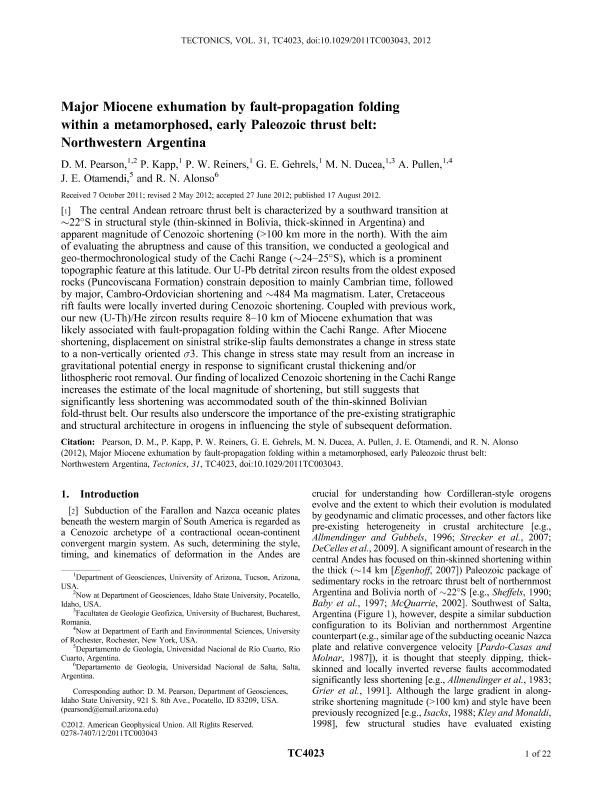Artículo
Major Miocene exhumation by fault-propagation folding within a metamorphosed, early Paleozoic thrust belt: Northwestern Argentina
Pearson, D. M.; Kapp, P.; Reiners, P. W.; Gehrels, G. E.; Ducea, M. N.; Pullen, A.; Otamendi, Juan Enrique ; Alonso, Ricardo Narciso
; Alonso, Ricardo Narciso
 ; Alonso, Ricardo Narciso
; Alonso, Ricardo Narciso
Fecha de publicación:
08/2012
Editorial:
American Geophysical Union
Revista:
Tectonics
ISSN:
0278-7407
Idioma:
Inglés
Tipo de recurso:
Artículo publicado
Clasificación temática:
Resumen
The central Andean retroarc thrust belt is characterized by a southward transition at ∼22°S in structural style (thin-skinned in Bolivia, thick-skinned in Argentina) and apparent magnitude of Cenozoic shortening (>100 km more in the north). With the aim of evaluating the abruptness and cause of this transition, we conducted a geological and geo-thermochronological study of the Cachi Range (∼24–25°S), which is a prominent topographic feature at this latitude. Our U-Pb detrital zircon results from the oldest exposed rocks (Puncoviscana Formation) constrain deposition to mainly Cambrian time, followed by major, Cambro-Ordovician shortening and ∼484 Ma magmatism. Later, Cretaceous rift faults were locally inverted during Cenozoic shortening. Coupled with previous work, our new (U-Th)/He zircon results require 8–10 km of Miocene exhumation that was likely associated with fault-propagation folding within the Cachi Range. After Miocene shortening, displacement on sinistral strike-slip faults demonstrates a change in stress state to a non-vertically orientedσ3. This change in stress state may result from an increase in gravitational potential energy in response to significant crustal thickening and/or lithospheric root removal. Our finding of localized Cenozoic shortening in the Cachi Range increases the estimate of the local magnitude of shortening, but still suggests that significantly less shortening was accommodated south of the thin-skinned Bolivian fold-thrust belt. Our results also underscore the importance of the pre-existing stratigraphic and structural architecture in orogens in influencing the style of subsequent deformation.
Palabras clave:
Miocene
,
Faulting
,
Folding
,
Salta
Archivos asociados
Licencia
Identificadores
Colecciones
Articulos(CCT - CORDOBA)
Articulos de CTRO.CIENTIFICO TECNOL.CONICET - CORDOBA
Articulos de CTRO.CIENTIFICO TECNOL.CONICET - CORDOBA
Articulos(CCT - NOA SUR)
Articulos de CTRO.CIENTIFICO TECNOL.CONICET - NOA SUR
Articulos de CTRO.CIENTIFICO TECNOL.CONICET - NOA SUR
Articulos(CCT - SALTA-JUJUY)
Articulos de CTRO.CIENTIFICO TECNOL.CONICET - SALTA-JUJUY
Articulos de CTRO.CIENTIFICO TECNOL.CONICET - SALTA-JUJUY
Articulos(INSUGEO)
Articulos de INST.SUP.DE CORRELACION GEOLOGICA
Articulos de INST.SUP.DE CORRELACION GEOLOGICA
Citación
Pearson, D. M.; Kapp, P.; Reiners, P. W.; Gehrels, G. E.; Ducea, M. N.; et al.; Major Miocene exhumation by fault-propagation folding within a metamorphosed, early Paleozoic thrust belt: Northwestern Argentina; American Geophysical Union; Tectonics; 31; 4; 8-2012; 1-22
Compartir
Altmétricas



